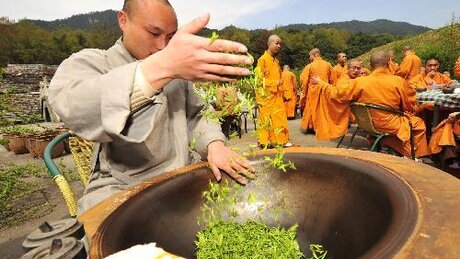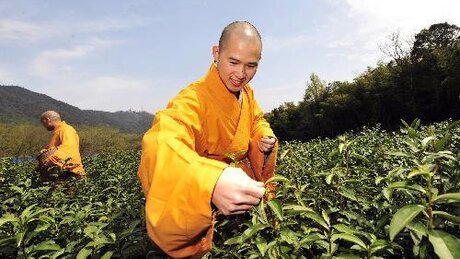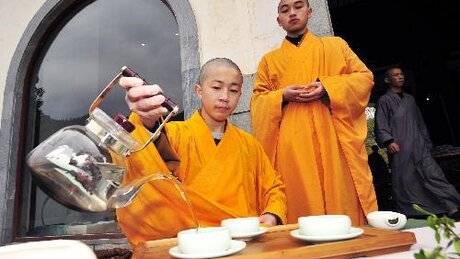Since the time of Han dynasty (from 206 B.C. to 220 A.D.) the tea evolves from being a mere medication into one of nutritive ingredients. It was still prepared in the pot tasting bitter and astringent. To soften the taste herbs, flowers, roots, salt and other substances were added. Therefrom originates the name of the period: «Soup tea».
At this particular time in Emeishan mountains local peasant Wu Li Zhen sets out first plantations for cultivation of tea. Previously tea plants were growing in a wild, often in hard-to-reach mountain areas. Therefore Wu Li Zhen took a major stride in the development of tea culture. He made the tea leaf available, turned the wild plant into domesticated one. In Emeishan mountains as well as in the whole Sichuan province he along with Lu Yu is venerated as a tea saint.
Contemporarily the tea production technology has changed as the tea leaves started to be processed by steaming. Tea became a beverage of everyday ration which is evidenced by multiple historical records. Such tea still remained aggressive to the stomach however already became an enjoyable drink. New processing technique and deliberate cultivation of tea has established new industry in China — the tea industry. Some people became professionally engaged in growing, processing and trade of tea.
In the 5th century, from India to China arrives the first patriarch of Ch’an Buddhism — Bodhidharma, in China known as Damo or Daruma in Japan. He brings new tradition — Buddhism, founds the monastery of Shaolin and practices meditation there.
Once after meditating for 9 consecutive years facing the wall in the cave on the top of Songshan mountain his eyelids descended and he fell asleep. Waken up the patriarch has torn own eyelids out so that they would never close again, has thrown them away and a tea plant has grown in the place they’ve touched the ground. Damo has brewed its fragrant leaves and felt the energy of the drink. All drowsiness has vanished away. On own body he experienced the magical effect of the divine plant — to bestow vivacity to the body and tranquility to the mind at the time of durable meditations. Since then the tea follows Buddhism in all ways of its expansion and comes to each country whenever Buddhist temples appear. Monks themselves are growing and producing tea replenishing own stock of valuable healing potion.
This tea growing period lasts for all troubled ages: from Han dynasty and up to the beginning of Tang dynasty (618–907) when tea from a medicine turns into the brew of gourmets.





